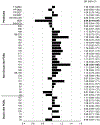Associations between persistent organic pollutants, type 2 diabetes, diabetic nephropathy and mortality
- PMID: 28438788
- PMCID: PMC6380355
- DOI: 10.1136/oemed-2016-103948
Associations between persistent organic pollutants, type 2 diabetes, diabetic nephropathy and mortality
Abstract
Objective: Relationships were examined between persistent organic pollutants (POPs) and incident type 2 diabetes, end-stage renal disease (ESRD) and mortality.
Methods: In a nested case-control study, 300 persons without diabetes had baseline examinations between 1969 and 1974; 149 developed diabetes (cases) and 151 remained non-diabetic (controls) during 8.0 and 23.1 years of follow-up, respectively. POPs were measured at baseline. ORs for diabetes were computed by logistic regression analysis. The cases were followed from diabetes onset to ESRD, death or 2013. HRs for ESRD and mortality were computed by cause-specific hazard models. Patterns of association were explored using principal components analysis.
Results: PCB151 increased the odds for incident diabetes, whereas hexachlorobenzene (HCB) was protective after adjusting for age, sex, body mass index, sample storage characteristics, glucose and lipid levels. Associations between incident diabetes and polychlorinatedbiphenyl (PCB) or persistent pesticide (PST) components were mostly positive but non-significant. Among the cases, 29 developed ESRD and 48 died without ESRD. PCB28, PCB49 and PCB44 increased the risk of ESRD after adjusting for baseline demographic and clinical characteristics. Several PCBs and PSTs increased the risk of death without ESRD. The principal components analysis identified PCBs with low-chlorine load positively associated with ESRD and death without ESRD, and several PSTs associated with death without ESRD.
Conclusions: Most POPs were positively but not significantly associated with incident diabetes. PCB151 was significantly predictive and HCB was significantly protective for diabetes. Among participants with diabetes, low-chlorine PCBs increase the risk of ESRD and death without ESRD, whereas several PSTs predict death without ESRD.
Keywords: Diabetes mellitus; PCBs; Pesticides; Renal.
© Article author(s) (or their employer(s) unless otherwise stated in the text of the article) 2017. All rights reserved. No commercial use is permitted unless otherwise expressly granted.
Conflict of interest statement
Competing interests: None declared.
Figures

References
-
- US EPA, O. of I. and T. A. & Office of International and Tribal Affairs, U. E. Persistent Organic Pollutants: A Global Issue, A Global Response. Available: http://www.epa.gov/international-cooperation/persistent-organic-pollutan.... Accessed 15 December 2015.
-
- US EPA, O. Basic Information| Polychlorinated Biphenyls (PCBs)| US EPA. Available: http://www.epa.gov/osw/hazard/tsd/pcbs/pubs/about.htm. Accessed 5 January 2016.
-
- Bonefeld-Jorgensen EC. Biomonitoring in Greenland: human biomarkers of exposure and effects - A short review. Rural Remote Health 2010; 10:1362. - PubMed
-
- Longnecker MP, Klebanoff MA, Brock JW, et al. Polychlorinated biphenyl serum levels in pregnant subjects with diabetes. Diabetes Care 2001; 24:1099–101. - PubMed
Publication types
MeSH terms
Substances
Grants and funding
LinkOut - more resources
Full Text Sources
Other Literature Sources
Medical
